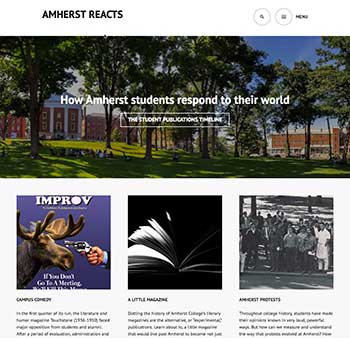Amherst Reacts: Through Comedy, Poetry and Protest
Combing through nearly two centuries of student publications preserved in Amherst’s Archives and Special Collections, student researchers have created a website that shows three ways Amherst students have reacted to campus life and the world around them: through comedy, poetry and protest.

Previous years’ Digital Scholarship Summer Interns have created interactive sites devoted to Edward Hitchcock, third president of Amherst College, and the College’s Kim-Wait/Eisenberg Native American Literature Collection.
Over eight weeks, this summer’s four interns—William Harvey ’18, Jennifer Lee ’17E, Norah Oteri ’18 and Phuong-Nghi Pham ’18—pored through 36 boxes of archival material spanning 90 linear feet, eventually summarizing content from 126 student publications from throughout Amherst’s history.
“Some of it was written by antebellum candlelight, some of it was in the trenches of World War II, and some of it was in the modern day, by a $10 Starbucks coffee,” said Harvey. “It’s really daunting to know the stuff that you write when you’re 19 years old will be remembered 200 years later.”
Looking at the history of protests on the Amherst campus and beyond, two interns went along two paths. Lee explored protests led by black students from 1966 to 1971, as recorded in The Amherst Student, while Oteri compiled interactive graphics charting student protests in general, comparing the 1965–1975 era with 2005–2015.
Lee said she wanted to create a resource for future student researchers. “I wanted to be able to cater to two different audiences: students who wanted a brief overview of what happened, and students who wanted to do more thorough research and go in depth.”
“Even though we don’t have a consistent amount, we have these renaissances of humor,” said Harvey, who tracked the history of student humor writing, mapping its topics and its targets, its productive periods and dry spells.
While early publications were primarily concerned with student life and academia, pop culture and politics drew more focus with each passing decade.
Phuong-Nghi Pham chose to research student literary magazines, which amount to one-third of the publications found in the Student Publications Collection. She zeroed in on IO (pronounced “eye-oh,” after the moon of Jupiter), an alternative magazine founded in 1965 by Richard Grossinger ’66 and Smith College student Lindy Hough, which mixed literature, science and history.
Unlike other such publications, IO survived its founders’ graduations and, she said, “in its post-Amherst incarnation established itself as one of the most influential magazines of the school of New American Poetry.” The magazine eventually morphed into the publishing house North Atlantic Books.
Sarah Walden, digital projects librarian at Frost Library, helped facilitate the research of the Digital Scholarship Summer Interns. “These students have been a pleasure to work with,” she said, “and their dedication, excitement and hard work have brought their scholarship to places I never would have expected at the beginning of the summer.”